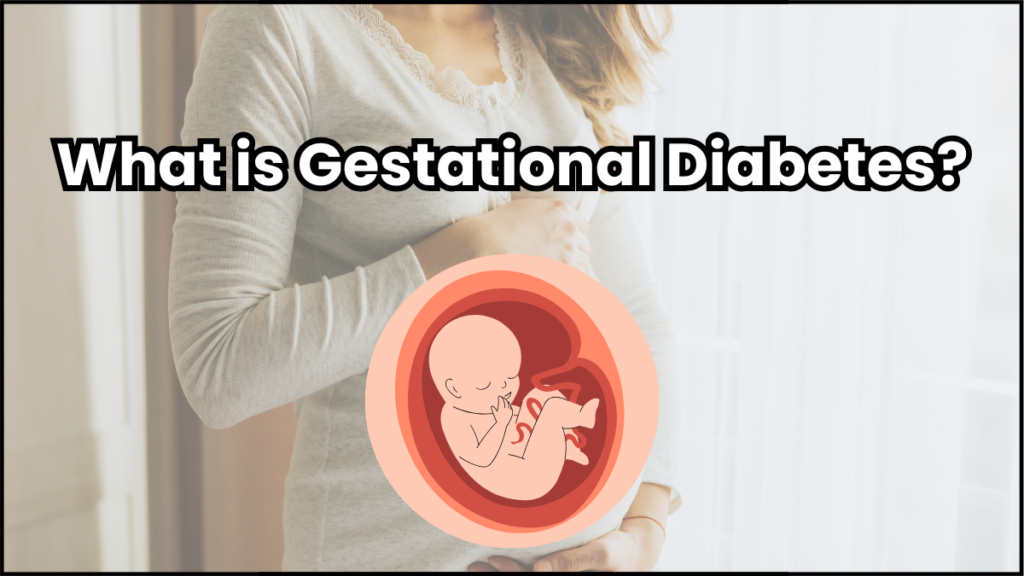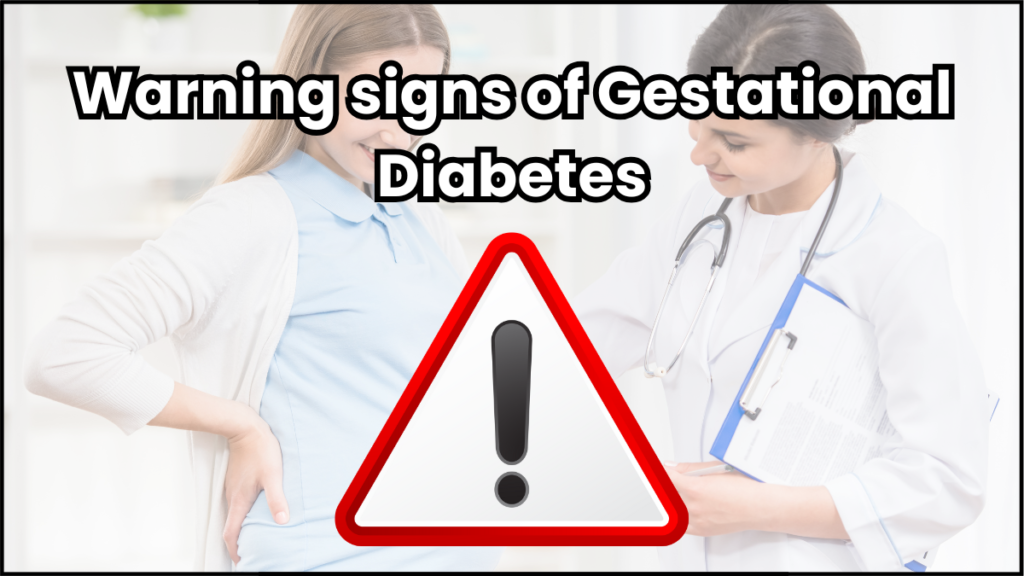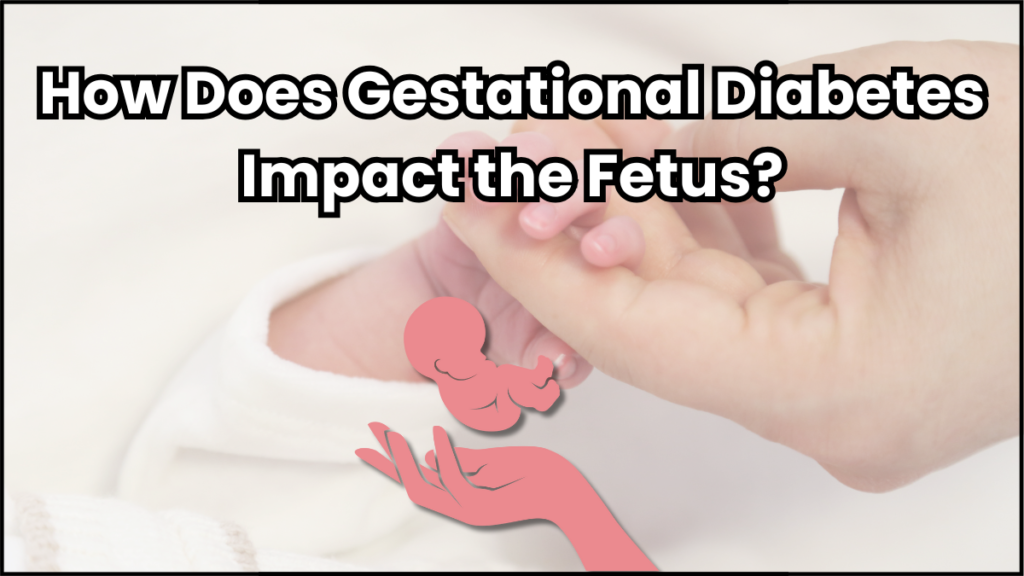Pregnancy is an exciting journey, but it also comes with many changes—including how your body processes sugar. Gestational diabetes is a type of diabetes that develops only during pregnancy, affecting how your body uses insulin.
While it usually goes away after childbirth, it requires careful management to ensure a healthy pregnancy for both mother and baby.
Many women with gestational diabetes don’t notice any symptoms, which is why doctors test for it between 24 and 28 weeks of pregnancy. However, some women may experience warning signs like excessive thirst, extreme fatigue, blurred vision, and rapid weight changes.
If left untreated, it can lead to complications such as high birth weight, premature birth, or an increased risk of developing type 2 diabetes later in life.
In this article, we’ll cover everything you need to know about gestational diabetes, including its warning signs, effects on the baby, whether it can go away, and how genetics may play a role.
Understanding this condition can help you take the right steps to manage it and ensure a safe and healthy pregnancy!
In this guide, we’ll discuss:
Table of Contents
Let’s dive in!
What is Gestational Diabetes?
Gestational diabetes occurs when a pregnant woman’s body can’t make enough insulin to control blood sugar levels. Insulin is the hormone that helps move glucose from the bloodstream into the cells for energy.
During pregnancy, hormones from the placenta make it harder for insulin to work properly. This is called insulin resistance. Usually, the body compensates by producing extra insulin.
But for some women, the body can’t keep up, leading to high blood sugar levels this is gestational diabetes.
The Role of Insulin in the Body Insulin is a hormone made by the pancreas. It helps move sugar (glucose) from the bloodstream into the cells used for energy. Too much sugar stays in the blood without enough insulin, leading to high blood sugar levels.

If you are looking for Best Supplements in the market then, Check out The Shop by Smart Sugar Control
What Happens During Pregnancy?
During pregnancy, the placenta produces hormones that help the baby grow. However, some of these hormones like human placental lactogen (hPL) and cortisol also make it harder for insulin to work properly.
This is called insulin resistance. As a result, the mother’s body has to produce more insulin to keep blood sugar levels regular. For most women, the pancreas can make enough extra insulin to compensate.
But for some, the pancreas can’t keep up, leading to high blood sugar levels this is gestational diabetes.
When Does It Develop?
Gestational diabetes usually develops in the second or third trimester, around 24–28 weeks of pregnancy. This is because pregnancy hormones become stronger as the pregnancy progresses, increasing insulin resistance.
Who is at Risk?
Some women are more likely to develop gestational diabetes than others. Risk factors include:
- Being overweight or obese before pregnancy
- Having a family history of type 2 diabetes
- Being over the age of 25
- Having polycystic ovary syndrome (PCOS)
- Having gestational diabetes in a previous pregnancy
Why is it Important to Manage Gestational Diabetes?
If left untreated, gestational diabetes can lead to complications for both the mother and baby. High blood sugar levels can cause the baby to grow too large, increasing the risk of C-section delivery. It can also lead to low blood sugar (hypoglycemia) in newborns after birth.
The good news is that gestational diabetes can be managed with the proper diet, exercise, and sometimes Medication. Early detection and appropriate care can help ensure a healthy pregnancy and baby.
Gestational diabetes is a temporary condition caused by pregnancy hormones affecting insulin function. With proper management, most women have healthy pregnancies and deliveries!
Warning Signs of Gestational Diabetes
Gestational diabetes can be tricky because it often doesn’t cause noticeable symptoms. Most women have it only after taking a routine glucose screening test between 24 and 28 weeks of pregnancy. However, some women may experience subtle warning signs indicating high blood sugar levels.

1. Extreme Thirst (Polydipsia)
Feeling thirsty during pregnancy is normal, but if you find yourself constantly needing water and your mouth always feels dry, it could be a sign of gestational diabetes.
Why does this happen?
When blood sugar levels are too high, the body tries to remove excess glucose through urine, causing frequent urination. This fluid loss dehydrates the body, triggering intense thirst as it attempts to restore hydration.
2. Frequent Urination (Polyuria)
Pregnancy naturally increases the need to urinate due to pressure on the bladder from the growing baby. However, with gestational diabetes, you might notice:
- More frequent trips to the bathroom than usual
- More significant amounts of urine being passed each time
Why does this happen?
High blood sugar levels make the kidneys work overtime to filter and remove excess glucose, producing more urine.
3. Fatigue and Extreme Tiredness
Pregnancy itself can cause tiredness, but unusual levels of exhaustion that don’t improve with rest could be a warning sign of gestational diabetes.
Why does this happen?
When sugar stays in the bloodstream instead of entering the cells (due to insulin resistance), your body lacks the energy it needs—making you feel drained, weak, or sluggish.
4. Blurred Vision
Some women with gestational diabetes experience sudden vision changes, such as:
- Blurriness
- Trouble focusing
- Increased sensitivity to light
Why does this happen?
High blood sugar levels affect fluid levels in the eyes, leading to temporary swelling in the eye’s lens. This changes its shape and focus, causing blurred vision. The good news? This is reversible once blood sugar levels are controlled.
5. Increased Hunger (Polyphagia)
Feeling hungrier than usual, even after eating a meal, can also be a sign of gestational diabetes.
Why does this happen?
Because the body can’t properly use glucose for energy, it keeps sending signals to the brain that you need more food—even when your stomach is full.
6. Unexplained Weight Changes
- Some women may experience sudden weight gain due to insulin resistance and fluid retention.
- Others may notice unexpected weight loss if their body starts breaking down fat for energy instead of using glucose.
7. Recurring Infections
If you are frequently experiencing infections, such as:
- Urinary tract infections (UTIs)
- Yeast infections (itching, discomfort, or discharge)
- Skin infections (slow-healing cuts or sores)
…it may be linked to gestational diabetes.
Why does this happen?
High blood sugar levels create an ideal environment for bacteria and yeast to grow, making infections more common.
Why These Symptoms Can Be Overlooked?
Many of these symptoms—such as fatigue, thirst, and frequent urination—are also typical pregnancy symptoms. That’s why routine blood sugar testing is so important.
When to See a Doctor?
If you notice several of these symptoms together, or if you feel more exhausted than usual, talk to your doctor about testing for gestational diabetes.
Even if you don’t have noticeable symptoms, attending all prenatal checkups and taking the glucose tolerance test at the recommended time (24–28 weeks) can help detect gestational diabetes early.
💡 Many women with gestational diabetes don’t have noticeable symptoms, but excessive thirst, frequent urination, extreme fatigue, and blurred vision can be warning signs. Routine testing is the best way to diagnose and manage the condition early!
Can Gestational Diabetes Go Away?
Yes! Gestational diabetes usually goes away after childbirth, but it’s essential to monitor your health because it can increase the risk of developing diabetes later in life.

What Happens After Delivery?
Once the baby and placenta are delivered, the hormones that cause insulin resistance drop significantly. As a result, the body’s insulin function typically returns to normal, and blood sugar levels stabilize within a few days after birth.
However, doctors recommend that women who have gestational diabetes:
Get a glucose test 6–12 weeks postpartum to check if blood sugar has returned to normal.
Continue monitoring their blood sugar periodically, as they are at a higher risk of developing type 2 diabetes in the future.
Does Gestational Diabetes Always Go Away?
For most women, gestational diabetes is temporary and resolves after delivery. However, in some cases:
- Blood sugar levels remain high even after birth.
- This could indicate undiagnosed type 2 diabetes or prediabetes that existed before pregnancy.
This is why follow-up testing is crucial to determine whether diabetes has disappeared.
Risk of Developing Type 2 Diabetes Later
Even if gestational diabetes disappears, about 50% of women who had it develop type 2 diabetes later in life—sometimes within 5 to 10 years after pregnancy.
Why does this happen?
- The body has already shown signs of insulin resistance.
- Pregnancy increases the demand for insulin, which can unmask an underlying risk for diabetes.
- Lifestyle factors such as poor diet and lack of exercise can contribute to the progression of type 2 diabetes.
How to Reduce the Risk of Future Diabetes?
Even if your blood sugar returns to normal after pregnancy, adopting healthy habits can help prevent future diabetes:
Eat a balanced diet – Focus on whole grains, lean proteins, healthy fats, and fibre-rich foods. Avoid processed foods and sugary snacks.
Stay active – Regular exercise (like walking, swimming, or yoga) improves insulin sensitivity and helps maintain a healthy weight.
Maintain a healthy weight – Losing 5–7% of body weight after pregnancy can significantly lower the risk of developing diabetes.
Breastfeed if possible – Breastfeeding helps regulate blood sugar and may lower the risk of developing type 2 diabetes.
Get regular checkups – Doctors recommend a glucose test every 1–3 years for women who have gestational diabetes.
What if You Get Pregnant Again?
If you had gestational diabetes once, you are at higher risk of developing it in future pregnancies. However, maintaining a healthy lifestyle before conception can help reduce the risk or delay its onset.
💡 Key Takeaway: Gestational diabetes usually goes away after childbirth, but women who have it are at a higher risk of developing type 2 diabetes later in life. Making healthy choices after pregnancy can help prevent diabetes and promote long term well being!
How Does Gestational Diabetes Impact the Fetus?
Gestational diabetes can affect the baby’s health if not managed properly. Since extra sugar crosses the placenta, the baby’s body responds by producing more insulin. This can lead to several complications, including:

1. Large Baby (Macrosomia)
Babies may grow too big (over 9 pounds) because of the extra sugar, making delivery more difficult. This increases the risk of:
C-section delivery
Birth injuries (shoulder dystocia)
2. Low Blood Sugar (Neonatal Hypoglycemia)
After birth, the baby may experience low blood sugar levels because the body is producing extra insulin while in the womb. This can lead to:
Jitteriness
Breathing problems
Seizures (in severe cases)
3. Higher Risk of Type 2 Diabetes Later in Life
Babies born to mothers with gestational diabetes are more likely to develop obesity and type 2 diabetes as they grow older.
Fortunately, proper management of gestational diabetes can prevent or reduce these risks!
Is Gestational Diabetes Genetic?
Yes, genetics can play a role in gestational diabetes. If diabetes runs in your family, you may have a higher risk of developing it. However, lifestyle factors also matter.
Women with a family history of type 2 diabetes are more likely to have gestational diabetes because their bodies may already have some degree of insulin resistance. That said, making healthy choices before and during pregnancy can lower your risk even if you have a genetic predisposition!
Signs of Gestational Diabetes in the Third Trimester
Gestational diabetes is usually diagnosed between 24–28 weeks, but symptoms can become more noticeable in the third trimester. Since blood sugar levels tend to rise as pregnancy progresses, managing them is essential to prevent complications for both the mother and baby.

1. Excessive Thirst & Frequent Urination
Feeling constantly thirsty and needing to urinate more often could be a sign of high blood sugar.
Why does this happen?
Excess glucose in the bloodstream forces the kidneys to work harder to filter it out, leading to more urination and dehydration, which triggers constant thirst.
2. Extreme Fatigue & Weakness
While pregnancy can cause tiredness, persistent exhaustion and weakness may indicate that your body isn’t processing glucose correctly.
Why does this happen?
Since the body can’t efficiently use sugar for energy, it leaves you feeling drained—even after getting enough sleep.
3. Blurred Vision
Sudden blurry vision or difficulty focusing could be due to fluctuating blood sugar levels.
Why does this happen?
High blood sugar affects fluid levels in the eyes, causing temporary swelling of the eye’s lens, leading to vision changes.
4. Increased Hunger (Even After Eating)
If you feel constantly hungry, your body might struggle to use glucose properly even after meals.
Why does this happen?
Since sugar stays in the bloodstream instead of being converted into energy, the brain signals the body to keep eating—even if you’ve already had enough food.
5. Unexplained Weight Changes
- Weight gain: Extra glucose may be stored as fat, increasing weight gain than expected.
- Weight loss: Unexpected weight loss can occur if the body burns fat instead of glucose for energy.
6. Frequent Infections
If you’re experiencing urinary tract infections (UTIs), yeast infections, or slow-healing wounds, high blood sugar may be the cause.
Why does this happen?
Excess sugar creates an ideal environment for bacteria and yeast to thrive, making infections more common.
7. Baby Growing Larger Than Normal (Macrosomia)
A baby that’s measuring more significant than usual for their gestational age might be a sign of gestational diabetes.
Why does this happen?
Excess glucose crosses the placenta, causing the baby’s pancreas to produce extra insulin, leading to excess fat storage.
Risks of a larger baby:
- Higher chances of a difficult vaginal delivery
- Increased risk of needing a C-section
- Newborn hypoglycemia (low blood sugar) after birth
8. High Blood Pressure & Swelling (Preeclampsia Risk)
Gestational diabetes increases the risk of preeclampsia, a condition that causes:
- High blood pressure
- Severe swelling (especially in hands and face)
- Protein in urine (detected in medical tests)
If left untreated, preeclampsia can be dangerous for both mother and baby.
When to See a Doctor
Talk to your doctor if you notice excessive thirst, extreme fatigue, blurry vision, or rapid weight changes.
How to Manage Gestational Diabetes:
- Healthy diet (low in refined carbs & sugar)
- Regular exercise (as recommended by your doctor)
- Blood sugar monitoring
- Medication or insulin (if needed)
💡 Key Takeaway: Gestational diabetes symptoms in the third trimester can include extreme thirst, excessive hunger, blurry vision, frequent infections, and a larger-than-normal baby. Proper management can help ensure a healthy pregnancy and a safe delivery!
How to Manage Gestational Diabetes?
The good news is that gestational diabetes can be managed with the right approach! Here’s how:
1. Eat a Healthy Diet 🍏
- Focus on whole grains, lean proteins, and vegetables
- Avoid sugary snacks and processed foods
- Eat smaller, balanced meals throughout the day to keep blood sugar stable
2. Exercise Regularly 🏃♀️
- Walking for 30 minutes a day can help regulate blood sugar
- Prenatal yoga or swimming are gentle but effective options
3. Monitor Blood Sugar Levels 🔬
- Your doctor may recommend checking your blood sugar levels at home
- Keeping a log of your readings can help track your progress
4. Medication if Needed 💊
- Some women may need insulin or other medications if diet and exercise alone aren’t enough
- Your doctor will determine the best treatment for you
If you are looking for Best Supplements in the market then, Check out The Shop by Smart Sugar Control
Final Thoughts: A Healthy Pregnancy is Possible!
Gestational diabetes is common, but it’s manageable with the proper care. The key is to stay informed, follow a healthy lifestyle, and work closely with your doctor.
Most women with gestational diabetes have healthy pregnancies and healthy babies. And the best part? Many healthy habits you develop during pregnancy can help you stay healthy for life!
If you’re pregnant and have concerns about gestational diabetes, talk to your doctor. Early detection and proper management can make all the difference! 💬 Did you find this article helpful? Let us know in the comments below! 😊
References
This article was written from the knowledge of Gestational Diabetes, diabetes prevention research, and expert health guidelines from reputable sources like:
Centers for Disease Control and Prevention (CDC) – www.cdc.gov
American Diabetes Association (ADA) – www.diabetes.org
National Institute of Diabetes and Digestive and Kidney Diseases (NIDDK) – www.niddk.nih.gov
Harvard T.H. Chan School of Public Health – www.hsph.harvard.edu
Mayo Clinic – www.mayoclinic.org
